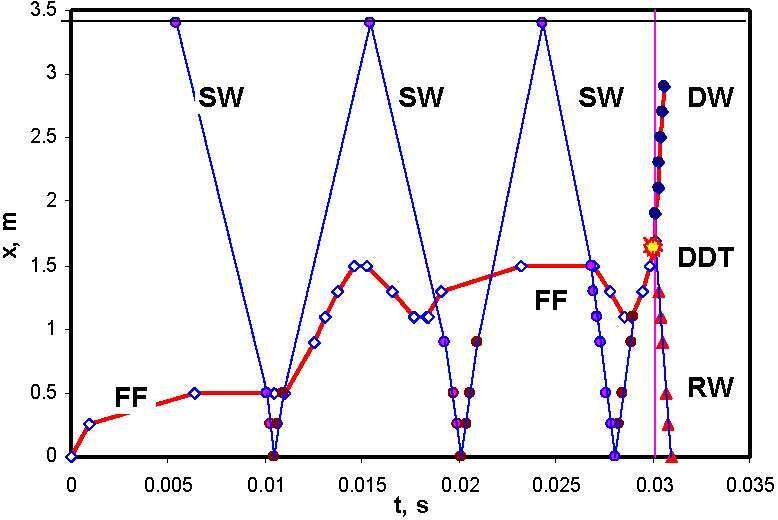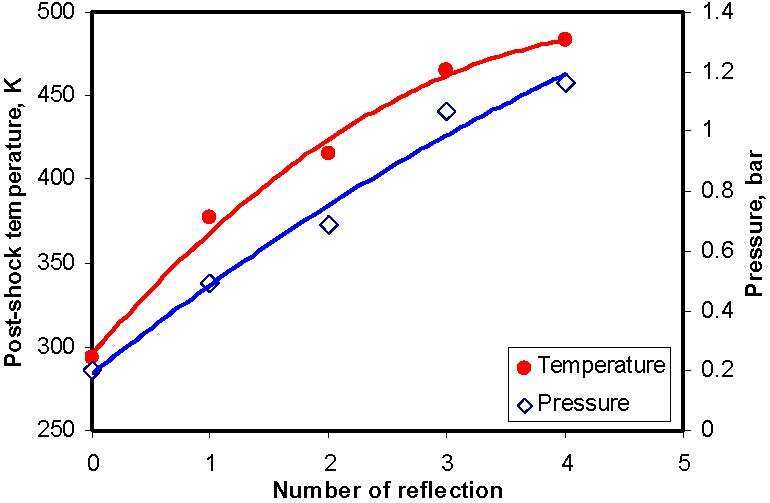One of the mechanisms of flame acceleration, shock wave amplification and preheat zone formation prior to DDT might be realized in relatively short tubes. Using relatively short tube with a tube length almost equal or less than run-up-distance to detonation, the detonation can be initiated after a collision or several collisions of reflected precursor shock wave with a counter flame front.
A series of experiments have been carried out in stainless steel detonation tube of 3.5 to 6-m long with rectangular cross-section of 50x50 mm. Stoichiometric hydrogen-oxygen mixtures at pressures 200, 500 and 750 mbar have been used as test mixtures. Flame acceleration (FA) mechanism and triggering from subsonic to sonic flame with following detonation onset were investigated using light sensors and a high speed camera combined with an optical schlieren system.
It was experimentally found that due to the Richtmaier-Meshkov instability during the shock-flame interaction the flame velocity suddenly increases in 10 times. Such a shock-flame interaction might happen several times, up to 5. Figure 1 shows the case with 3 reflections before the detonation onset. As it follows from the diagram, the run-up-distance to DDT point is reduced to 2.4-2.5 m (2-3 times shorter than for long tube with L/D >> 100).

Figure 1. X-t diagram of DDT process in relatively short tube filled with stoichiometric
H2-O2 mixture: FF=flame front (red line); SW=shock wave (blue lines); DW=detonation wave (red line); RW=retonation wave (blue line).
The detonation may also occur after multiple shock wave reverberations because the pressure and the temperature of unburned material will reach the conditions for the flame to be accelerated fast enough for DDT. For instance, in comparison with an initial state, the pressure grows in 6 times, the temperature in 2 times and the laminar flame speed in 6 times after 5 reflections (Fig. 2). This means that the shock-flame interaction and adiabatic compression of unreacted material play very important role for detonation preconditioning and DDT process in such case. Boundary layer and turbulence do not play so significant role for DDT in relatively short smooth tubes filled with highly reactive mixtures.

Figure 2. Actual post-shock pressure and temperature of unreacted material due multiple reflections (initial pressure 200 mbar).
A series of 1D-numerical simulations of hydrogen-oxygen mixture at sub-atmospheric pressures in a tube 12.5-m long was done. It was also shown that in case of multiple reflections of precursor shock wave the post-shock temperature may reach 500K. The strength of precursor shock in terms of overpressure may increase 7 times in comparison with incident precursor shock wave. These simulations have been done with respect to the safety in order to demonstrate that even a limited space and a reduced pressure may lead to very strong hydrogen explosion with a maximum pressure 100 times higher than initial sub-atmospheric pressure.
Experimental data on flame acceleration, shock-flame interaction and deflagration-to-detonation transition mechanism for stoichiometric hydrogen-oxygen mixtures in 1D geometry have been analysed. Results of the work will provide detailed information on mutual shock - flame interactions leading to the DDT process and for numerical code validations.

